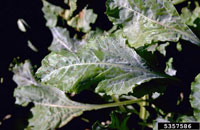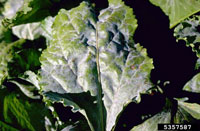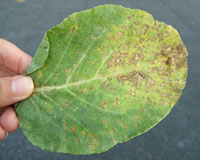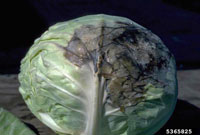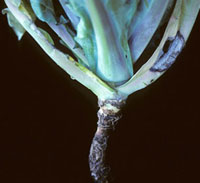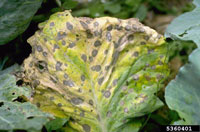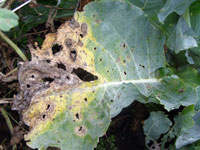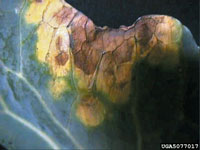Extension > Garden > Diagnose a problem > What's wrong with my plant? > Vegetable > Cabbage > Spots on leaves
Cabbage > Leaves > Spots on leaves
1 of 5
Powdery Mildew
Erysiphe polygoni
- Initially pale yellow spots on leaves
- White to gray powdery felt in spots, blotches or complete covering of leaves
- Spots develop on underside of leaves, or on shaded leaves first
2 of 5
Downy Mildew
Peronospora parasitica
- Gray-white sunken leaf spots which are often angular and restricted by the leaf veins
- Leaf tissue around the spots turns yellow
- Fuzzy gray growth can be seen on the underside of the leaves
- Numerous black sunken spots can form on infected heads
- Disease is common in cool wet weather
- More information on Downy Mildew
3 of 5
Black Leg
Phoma lingam
- Leaves develop yellow spots with gray centers
- Stem develops bluish black discoloration
- Stem lesion becomes sunken brown with a purple black border
- Plants eventually wilt and topple over
- More information on Black Leg
4 of 5
Black Leaf Spot/Gray Leaf Spot
Alternaria spp.
- Gray to black round leaf spots with concentric rings
- Leaf tissue becomes dry, brittle and often falls out, resulting in a ‘shot hole’ appearance
- Leaf spots often appear first on lower older leaves
- More information on Leaf Spot
5 of 5
Black Rot
Xanthomonas campestris
- Yellow V-shaped lesions develop on margin of leaves, the point of the v follows a vein towards the base of the leaf
- As infection continues, leaves wilt, turn yellow and eventually turn brown and die
- Black veins can be seen in infected leaves, petioles and stems
- Sticky yellowish liquid bacterial ooze may be seen if infected veins are cut
- Disease favored by hot, humid conditions
- More information on Black rot



